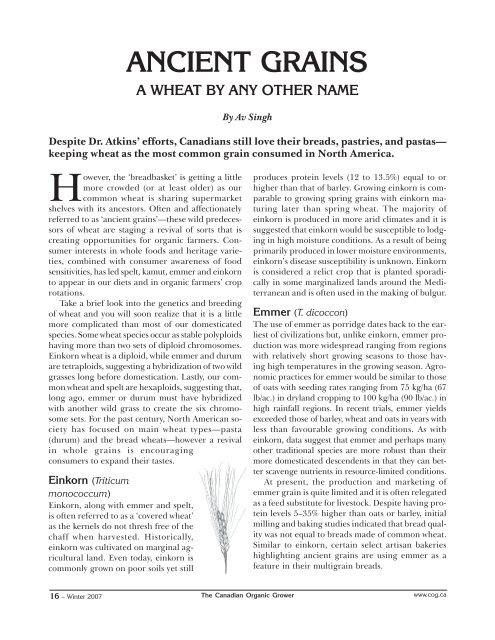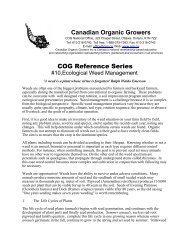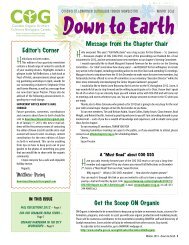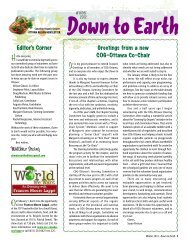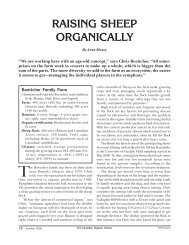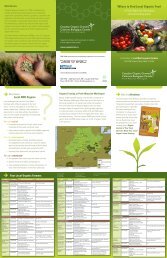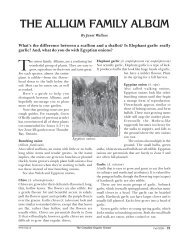ANCIENT GRAINS - Canadian Organic Growers
ANCIENT GRAINS - Canadian Organic Growers
ANCIENT GRAINS - Canadian Organic Growers
You also want an ePaper? Increase the reach of your titles
YUMPU automatically turns print PDFs into web optimized ePapers that Google loves.
However, the ‘breadbasket’ is getting a little<br />
more crowded (or at least older) as our<br />
common wheat is sharing supermarket<br />
shelves with its ancestors. Often and affectionately<br />
referred to as ‘ancient grains’—these wild predecessors<br />
of wheat are staging a revival of sorts that is<br />
creating opportunities for organic farmers. Consumer<br />
interests in whole foods and heritage varieties,<br />
combined with consumer awareness of food<br />
sensitivities, has led spelt, kamut, emmer and einkorn<br />
to appear in our diets and in organic farmers’ crop<br />
rotations.<br />
Take a brief look into the genetics and breeding<br />
of wheat and you will soon realize that it is a little<br />
more complicated than most of our domesticated<br />
species. Some wheat species occur as stable polyploids<br />
having more than two sets of diploid chromosomes.<br />
Einkorn wheat is a diploid, while emmer and durum<br />
are tetraploids, suggesting a hybridization of two wild<br />
grasses long before domestication. Lastly, our common<br />
wheat and spelt are hexaploids, suggesting that,<br />
long ago, emmer or durum must have hybridized<br />
with another wild grass to create the six chromosome<br />
sets. For the past century, North American society<br />
has focused on main wheat types—pasta<br />
(durum) and the bread wheats—however a revival<br />
in whole grains is encouraging<br />
consumers to expand their tastes.<br />
Einkorn (Triticum<br />
monococcum)<br />
Einkorn, along with emmer and spelt,<br />
is often referred to as a ‘covered wheat’<br />
as the kernels do not thresh free of the<br />
chaff when harvested. Historically,<br />
einkorn was cultivated on marginal agricultural<br />
land. Even today, einkorn is<br />
commonly grown on poor soils yet still<br />
16 – Winter 2007<br />
<strong>ANCIENT</strong> <strong>GRAINS</strong><br />
A WHEAT BY ANY OTHER NAME<br />
By Av Singh<br />
Despite Dr. Atkins’ efforts, <strong>Canadian</strong>s still love their breads, pastries, and pastas—<br />
keeping wheat as the most common grain consumed in North America.<br />
The <strong>Canadian</strong> <strong>Organic</strong> Grower<br />
produces protein levels (12 to 13.5%) equal to or<br />
higher than that of barley. Growing einkorn is comparable<br />
to growing spring grains with einkorn maturing<br />
later than spring wheat. The majority of<br />
einkorn is produced in more arid climates and it is<br />
suggested that einkorn would be susceptible to lodging<br />
in high moisture conditions. As a result of being<br />
primarily produced in lower moisture environments,<br />
einkorn’s disease susceptibility is unknown. Einkorn<br />
is considered a relict crop that is planted sporadically<br />
in some marginalized lands around the Mediterranean<br />
and is often used in the making of bulgur.<br />
Emmer (T. dicoccon)<br />
The use of emmer as porridge dates back to the earliest<br />
of civilizations but, unlike einkorn, emmer production<br />
was more widespread ranging from regions<br />
with relatively short growing seasons to those having<br />
high temperatures in the growing season. Agronomic<br />
practices for emmer would be similar to those<br />
of oats with seeding rates ranging from 75 kg/ha (67<br />
lb/ac.) in dryland cropping to 100 kg/ha (90 lb/ac.) in<br />
high rainfall regions. In recent trials, emmer yields<br />
exceeded those of barley, wheat and oats in years with<br />
less than favourable growing conditions. As with<br />
einkorn, data suggest that emmer and perhaps many<br />
other traditional species are more robust than their<br />
more domesticated descendents in that they can better<br />
scavenge nutrients in resource-limited conditions.<br />
At present, the production and marketing of<br />
emmer grain is quite limited and it is often relegated<br />
as a feed substitute for livestock. Despite having protein<br />
levels 5–35% higher than oats or barley, initial<br />
milling and baking studies indicated that bread quality<br />
was not equal to breads made of common wheat.<br />
Similar to einkorn, certain select artisan bakeries<br />
highlighting ancient grains are using emmer as a<br />
feature in their multigrain breads.<br />
www.cog.ca
Marc Loiselle combining organic Red Fife wheat on his farm<br />
near Vonda, Saskatchewan.<br />
Spelt (T. aestivum spelta)<br />
Spelt is by far is the most<br />
common of the hulled<br />
wheats. There are both<br />
spring and winter spelt<br />
cultivars, with winter seeding<br />
more common for organic<br />
farmers. Despite the<br />
obvious comparisons with<br />
winter wheat, spelt has only<br />
moderate nitrogen requirements<br />
(25–50% lower)<br />
making it an even better fit<br />
for organic systems. Spelt<br />
has a variable seeding rate ranging<br />
from 130 to 200 kg/ha (116–<br />
180 lb/ac.) depending on<br />
weediness and available moisture.<br />
It is sown at or near the same time<br />
as winter wheat. Spelt is sown<br />
slightly deeper (at a depth of 3 cm<br />
or just over an inch) than wheat<br />
allowing a dense root system to develop,<br />
thus preventing any opportunity<br />
for heaving during<br />
freeze-thaw cycles.<br />
Harvesting of spelt may be 8<br />
to 10 days before winter wheat<br />
and it is usually combined with<br />
great care in order to avoid<br />
dehulling. Spelt straw is brittle,<br />
but of high quality and high<br />
quantity. It is very desirable as<br />
mulch or for bedding. With the<br />
early harvest, many organic farmers<br />
can underseed red clover into<br />
spelt early in spring or use catch<br />
crops like buckwheat or oilseed<br />
radish following harvest.<br />
Advances in spelt breeding are<br />
generating new varieties often selected<br />
for disease hardiness. Common<br />
spelt is susceptible to leaf<br />
rust, fusarium, powdery mildew<br />
and loose smut. In cool moist<br />
springs, spelt may have an advantage<br />
over other grains in terms of<br />
staving off soil-borne diseases because<br />
of its thick hull.<br />
Initially, <strong>Canadian</strong> spelt was<br />
exported for the European market,<br />
however renewed interest has<br />
led spelt flour to be substituted for<br />
wheat flour in many products. People<br />
with allergies to wheat starch<br />
commonly report that spelt is<br />
easier to digest, however for people<br />
with gluten allergies (celiac<br />
disease), spelt will be no different<br />
than wheat.<br />
Kamut (T. durum)<br />
The origin of Kamut is somewhat<br />
confusing and its anecdotal arrival<br />
to North America would make<br />
good fiction. The very name<br />
kamut is in fact a registered trademark<br />
of Kamut International, and<br />
is based upon the Egyptian word<br />
for durum wheat.<br />
Regardless of its origin or history,<br />
kamut is making a foothold<br />
in the organic grain market.<br />
Kamut kernels are twice the size<br />
of wheat kernels and are characterized<br />
by a hump shape, but it is<br />
best known for its distinctive nutty,<br />
buttery flavour. Agronomic practices<br />
for producing kamut would<br />
be similar to those of durum or<br />
hard red spring wheat. Unlike<br />
other ancient grains, a contract<br />
guaranteeing organic production<br />
is required to grow kamut. Like all<br />
of the other alternative wheats,<br />
kamut will outyield other spring<br />
wheats when environmental<br />
stresses are experienced during<br />
the growing season and will have<br />
equal to or slightly lower yields in<br />
ideal growing conditions. Kamut<br />
is a tall growing (130 cm / 50 in.)<br />
wheat species generating an excellent<br />
quality straw.<br />
Traditional wheat species<br />
Growing alternative grains may<br />
not be suitable for all organic<br />
farmers especially those not familiar<br />
with cereal production.<br />
The primary benefits of alternative<br />
grains are to capture a niche<br />
market and to grow a competitive<br />
crop that can perform well<br />
under less than ideal growing<br />
conditions. However, there are<br />
challenges such as susceptibility<br />
to disease, variance in yields and<br />
protein content, extra costs associated<br />
with dehulling, and<br />
sourcing markets.<br />
www.cog.ca The <strong>Canadian</strong> <strong>Organic</strong> Grower<br />
Winter 2007 – 17
Spring wheat (T. aestivum)<br />
There are several classes of spring<br />
wheat, namely: durum, hard red,<br />
hard white and soft white.<br />
• Durum has large, very hard,<br />
translucent kernels. The<br />
endosperm is used to make semolina<br />
flour for products such as<br />
pasta and couscous.<br />
Hard red spring (HRS) wheat<br />
kernels are brownish in colour and<br />
high in protein (gluten) which<br />
leads to good bread baking.<br />
Hard white wheat has moderate<br />
protein levels and is typically<br />
grown in more arid conditions. Its<br />
flour is used in bread, especially<br />
flatbreads, such as tortillas and<br />
pitas.<br />
Soft white wheat grows well in<br />
more temperate climates and its<br />
low protein content makes its flour<br />
ideal for pastries.<br />
Spring wheat works well in organic<br />
rotations because of its competitiveness<br />
with weeds and<br />
because of its value as a cash crop.<br />
Generally, spring wheat is seeded<br />
at 100–160 kg/ha (89–143 lb/ac.)<br />
at a depth of 5–8 cm (2–3 in.) having<br />
only moderate nutrient demands.<br />
Winter wheat (T. aestivum)<br />
The majority of organic wheat<br />
grown in Canada is spring wheat,<br />
but many organic farmers work<br />
winter wheat into their rotations<br />
quite well. Winter wheat is grown<br />
over a wide range of environments<br />
(similar to those of spelt) and is<br />
used primarily for flour with<br />
moderate to high protein levels.<br />
Winter wheat is considered a<br />
heavy feeder in terms of nutrients<br />
and therefore it works well after a<br />
late summer plowdown of a hay<br />
or clover crop. Similar to spelt,<br />
winter wheat seeding rates are<br />
quite variable depending on soil<br />
18 – Winter 2007<br />
Doug Brown of Oak Haven Bakery in Annapolis County, Nova<br />
Scotia, specializes in naturally-leavened breads made from<br />
organic spelt and kamut flour.<br />
moisture and date of seeding—<br />
increased rates where more moisture<br />
is available and when seeding<br />
is done later in fall. Winter wheat,<br />
like spelt, is harvested in mid-summer<br />
allowing for a catch crop, like<br />
oilseed radish, to be planted after<br />
the wheat harvest. Winter wheat<br />
produces a high quality straw that,<br />
if not used for livestock, can be<br />
disked into the top 10–15 cm (4–<br />
6 in.) of the soil along with manure<br />
followed by the seeding of<br />
the catch crop.<br />
Conclusions<br />
The greatest benefits in growing<br />
the more common wheat species<br />
are having disease-resistant<br />
varieties available; a certified<br />
weed-free seed source; established<br />
markets; and tried and tested agronomic<br />
practices.<br />
<strong>Organic</strong> farmers are constantly<br />
looking for new niche markets to<br />
capture the ever-changing health<br />
trends of consumers. Renewed in-<br />
The <strong>Canadian</strong> <strong>Organic</strong> Grower<br />
terest in whole grain breads, coupled<br />
with sensitivities to common<br />
breads, has launched another level<br />
of value-added crops to an organic<br />
farmer’s rotation. The alternative<br />
wheat species have distinctive characteristics<br />
that will attract artisan<br />
bakers and consumers, and they<br />
feature a robustness and resilience<br />
in their growth ability that separates<br />
them from our common<br />
wheat.<br />
Av Singh, PhD, PAg, is the <strong>Organic</strong><br />
and Rural Infrastructure Specialist<br />
with AgraPoint Inc. in Nova Scotia<br />
and is available for comment or<br />
question at 902-896-0277 or at<br />
a.singh@agrapoint.ca.<br />
Photo credits: Brenda Frick and<br />
Janet Wallace.<br />
Line drawings by Sylvia Welke.<br />
www.cog.ca


